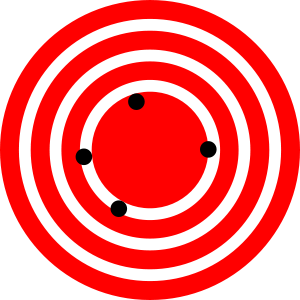
Image via Wikipedia
To enable purchasers to compare commercially available instruments and evaluate new instrument designs, quantitative criteria for the performance of instruments are needed. These criteria must clearly specify how well an instrument measures the desired input and how much the output depends on interfering and modifying inputs. Characteristics of instrument performance are usually subdivided into two classes on the basis of the frequency of the input signals.
Static characteristics describe the performance of instruments for dc or very low frequency inputs. The properties of the output for a wide range of constant inputs demonstrate the quality of the measurement, including nonlinear and statistical effects. Some sensors and instruments, such as piezoelectric devices, respond only to time-varying inputs and have no static characteristics.
Introduction
The body produces various physiological signals. The accessibility to these signals is important because
(1) they can be internal (blood pressure)
(2) they may emanate from the body (infrared radiation)
(3) they may be derived from a tissue sample (blood or tissue biopsy)
All physiological signals can be grouped into the following categories –
(1)biopotential
(2) pressure
(3) flow
(4)dimensions( for example : imaging)
(5)displacement (such as velocity, force, andacceleration)
(6) impedence
(7) temperature
(8) chemical concentration and composition.
Some times, it become essential to monitor physiological events from a distant place.
Some of such situations are:
(a) Monitoring of astronauts during flight.
(b) Monitoring of patients in ambulance while transit to hospital.
(c) Monitoring of patients while obtaining their exercise electrocardiogram.
(d) Monitoring of patients who are permitted to stay away from the hospital.
(e) Monitoring of animals in their natural habitat.
(f) Transmission of ECG or other medical information through telephone links
(g) Isolating the patients from electricity operated measuring equipment such as ECG equipment inorder to prevent any accidental shock to them.
Despite recent controversies regarding its safety and efficacy, pulmonary artery catheterization
(PAC) remains a widely used tool for the management of patients with cardiovascular instability. In addition to providing measurements of cardiac out-put (CO), several other potentially useful pieces of data can be obtained, including estimates of preload,afterload, and oxygen utilization. However, many practitioners feel that CO is the most useful parameter obtained with PAC.The desire to measure CO without the risks of PAC has driven the search for other, less invasive measurement methods, such as esophageal Doppler measurements, lithium dilution, and carbon dioxide based techniques.
Factors Influencing Cardiac Output

